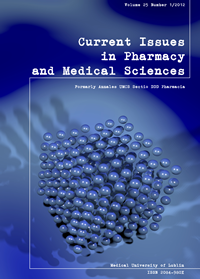Determination of the level of chromium and nickel in selected dietary supplements stimulating the immune system of the human body
DOI:
https://doi.org/10.12923/j.2084-980X/25.1/a.02Słowa kluczowe:
dietary supplements, chromium, nickel, atomic absorption spectrometryAbstrakt
An important group of dietary supplements are those preparations stimulating the defence mechanism of the human body. Often powdered plant raw materials or dry extracts from herbs are included in these dietary supplements, therefore these preparations, apart from being biologically active, can contain considerable quantities of the mineral matter. The purpose of our work was to assess the levels of chromium and nickel in selected dietary supplemental products produced in the form of capsules and pills (Acerola Plus, Cat's Claw, Maca, Maca 50 Plus, Spirulina, Spirulina Hawaian, Spirulina Pacifica, Vilcacora, Żeń-szeń from the “Herbalist's Plants of 'Herbapol' in Cracow”, Żeń-szeń – Ginseng from “KRKA”, Żeń-szeń supplied by Naturell, Żeń-szeń Korean from “Walmark”, Żeń-szeń supplied by “Vita-complex”) and in liquid preparations (Aloe - juice, Aloe vera drinking gel, Aloes Activ, Aloes Young, Bodymax Tonik, Ginsengin 400, Ginsenol, Noni - juice, Noni-vita, Noni Plus). Prepared Samples (3-5) of each of preparations were examined, in two parallel runs with analysis was carried out using a Pye Unicam SP 192 atomic absorption spectrometer, while applying specific determination parameters for given element. In supplements in the form of capsules and pills, the chromium content fluctuated, on average, from 0.33 μg/g (Acerola Plus), to 13.79 μg/g (Spirulina), and of nickel, from 0.16 μg/g (Acerola Plus), to 4.10 μg/g (Żeń-szeń (ginseng) - “Herbalist's Plants of 'Herbapol' in Cracow'). In the liquid dietary supplements that were tested, the values were as follows: the amounts of chromium were up to 0.12 μg/ml, while nickel was up to 0.27 μg/ml. In studied preparations, chromium and nickel levels diverged widely, depending on the form and composition of the dietary supplement. What is more, special predispositions of certain raw plant materials (marine alga - spirulina and of root of ginseng) were observed, for the accumulation of the determined micro-elements.
Bibliografia
1. Berner, T.O., Murphy M.M. and Slesinski R.: Determining the safety of chromium tripicolinate for addition to food as a nutrient supplement. Food Chem. Toxicol., 42, 1029, 2004.
2. Błoniarz, J. and Zaręba S.: Selected microelements (Cr, Zn, Cu, Mn, Fe, Ni) in slimming preparations. Roczn. PZH, 58, 165, 2007.
3. Błoniarz, J.: Study of some microelements level in selected preparations containing phytoestrogens. Polish J. Environ. Stud., 17 (1B), 18, 2008.
4. Błoniarz, J. and Zaręba S.: Evaluation of the level of chromium and nickel in selected dietary supplements (containing antioxidant compounds) available in Poland. Annal. UMCS, Sectio DDD, 23, 51, 2010.
5. Błoniarz, J. and Zaręba S.: Badanie zawartości niklu i chromu w suplementach diety wspomagających odchudzanie. Roczn. PZH, 62, 153, 2011.
6. Cogne, G. et al.: Uptake of macrominerals and trace elements by the cyanobacterium Spirulina platensis (Arthrospira platensis PCC 8005) under photoautotrophic conditions: culture medium optimization. Biotechnol. Bioeng. 81, 588, 2003.
7. Dybczyńki, R. et al.: Preparation and certification of the Polish reference material „Mixed Polish Herbs” (INST-MPH-2) for inorganic trace analysis, Raporty IChTJ, Seria A nr 4/2002, Institute of Nuclear Chemistry and Technology, Warszawa 2002.
8. European Commission Health and Consumer Protection Directorate-General. Scientific Committee on Food. Opinion of the Scientific Committee on Food on the Tolerable Upper Intake Level of Trivalent Chromium. Brussels 2003.
9. Food and Nutrition Board. Institute of Medicine. Dietary References Intakes for vitamin A, vitamin K, arsenic, boron, chromium, copper, iodine, iron, manganese, nickel, silicon, vanadium, and zinc. National Academy Press, Washington, DC 2001.
10. Kim, M.H., et al.: Immunomodulatory activity of ginseng, a polysaccharide of Panax ginseng, on dendritic cells. Korean J. Physiol. Pharmacol., 13, 169, 2009.
11. Leśniewicz, A., Jaworska K. and Żyrnicki W.: Macro- and micro-nutrients and their bioavailability in Polish herbal medicaments. Food Chem. 99, 670, 2006.
12. Mechanick, J.I. et al.: American Association of Clinical Endocrinologists Medical Guidelines for the clinical use of dietary supplements and nutraceuticals. AACE Nutrition Guidelines Task Force. Endocrine Practice, 9, 417, 2003.
13. Pinta, M. (1977). Absorpcyjna spektrometria atomowa. Zastosowanie w analizie chemicznej. PWN, Warszawa.
14. Raport „Rynek suplementów diety w Polsce 2009”, PMR Publications, dział PPMR, 2009; www.pmrpublications.com.
15. Reis, S.R.I.N. et al.: Immunomodulating and antiviral activities of Uncaria tomentosa on human monocytes infected with Dengue Virus-2. Int. Immunopharm., 8, 468, 2008.
16. Sapek, A.: Oznaczanie ołowiu, niklu i kobaltu w wyciągu glebowym metodą ASA, po zagęszczeniu do fazy organicznej. Chem. Anal., 19, 687, 1974.
17. Stoś, K. et al.: Suplementy diety jako źródło składników o działaniu odżywczym i innym fizjologicznym. Żyw. Człow. Metabol., 34, 1036, 2007.
Pobrania
Opublikowane
Numer
Dział
Licencja
Prawa autorskie (c) 2012 Autorzy

Praca jest udostępniana na licencji Creative Commons Attribution-NonCommercial-NoDerivatives 3.0 Unported License.


